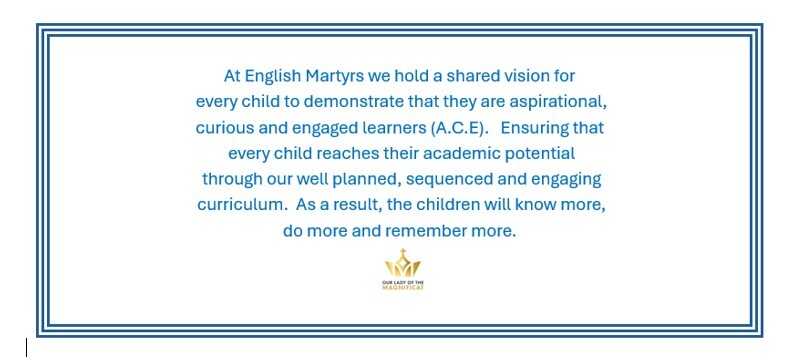- Home
- Curriculum
- Subject Information
- Art and Design
Art and Design

What does this look like in Art and Design?
At English Martyrs Catholic Primary School, we value Art and Design as an important part of the children’s entitlement to a broad and balanced curriculum. Art and Design provides the children with the opportunities to develop and extend skills and an opportunity to express their individual interests, thoughts and ideas.
Curriculum Intent:
Through our curriculum planning, artists at English Martyrs engage with a variation of opportunities, in weekly lessons following the Kapow scheme of work.
We aim for all pupils to:
- Be aspirational in their work; to challenge themselves to create works of art they are proud of and to develop new skills; to be reflective and evaluate their work, thinking about how they can make changes and keep improving.
- Develop curiosity; asking questions about how works of art were created and how they can develop their own skills.
- Be fully engaged in art lessons, developing a love of experimentation, to think critically about their work.
Curriculum Implementation:
Lessons are always practical in nature and encourage experimental and exploratory learning with pupils using sketchbooks to document their ideas. Differentiated guidance is available for every lesson to ensure that lessons can be accessed and enjoyed by all pupils and opportunities to stretch pupils’ learning are available when required. Knowledge organisers for each unit support pupils by providing a highly visual record of the key knowledge and techniques learned, encouraging recall of skills processes, key facts and vocabulary.
What a typical lesson looks like:
Flashback: an opportunity for pupils to retrieve and build upon previously acquired skills, through a ‘Last Lesson, Last Unit, Last Year, Challenge’ approach.
Teach it: introduction to new a new skill with live modelling and explicit addressing of potential misconceptions. Learning about the work of famous local, national and international artists are explored to enhance the children's learning.
Practise it Children use sketch books to record ideas, practise different skills and experiment with different techniques.
Prove it Evaluating and analysing,
Dig deeper Further develop skills and interpretation of work means
Art is also used within other areas of the curriculum to enable pupils to represent their thoughts and ideas visually. It can be used as a stimulus for literacy, to portray complex emotions in RE or to deepen understanding in maths
Assessment
Live marking/discussions about their work and ways to improve their work.
Assessment based on National Curriculum
Curriculum Impact:
Kapow Primary’s curriculum is designed in such a way that children are involved in evaluation, dialogue and decision making about the quality of their outcomes and the improvements they need to make. By taking part in our regular discussions and decision making processes, children will not only know facts and key information about art, but they will be able to talk confidently about their own learning journey, have higher metacognitive skills and have a growing understanding of how to improve.
The impact of Kapow Primary’s scheme can be constantly monitored through both formative and summative assessment opportunities. Each lesson includes guidance to support teachers in assessing pupils against the learning objectives. An assessment spreadsheet including the learning outcomes for children with secure understanding and those working at greater depth enables teachers to keep records of summative assessments for each child.
After the implementation of Kapow Primary’s Art and design scheme, pupils should leave primary school equipped with a range of techniques and the confidence and creativity to form a strong foundation for their Art and design learning at Key Stage 3 and beyond.
The expected impact of following the Kapow Primary Art and design scheme of work is that children will:
- Produce creative work, exploring and recording their ideas and experiences.
- Be proficient in drawing, painting, sculpture and other art, craft and design techniques.
- Evaluate and analyse creative works using subject-specific language.
- Know about great artists and the historical and cultural development of their art.
- Meet the end of key stage expectations outlined in the National curriculum for Art and design